The Public Life of Sherlock Holmes: The Hammer Hound
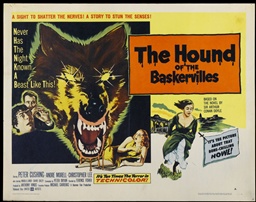
Last week, we looked at Tom Baker’s relatively unknown Hound of the Baskervilles. As this post is being published on May 26, which is the birthday of a classic Holmes, we’ll look his version of The Hound. For on this date in 1913, Peter Cushing was born in Surrey.
Basil Rathbone’s contract expired in 1946 and, feeling imprisoned in the role of Sherlock Holmes, he refused to renew it. So great was his shadow that it would be thirteen years before another studio even attempted to make a Sherlock Holmes movie. Hammer Films is legendary in England for their run of horror films, starting in the fifties.
Those old Universal classics from America had never caught on across the pond. Hammer, however, made a series of successful horror films, frequently co-starring Peter Cushing and Christopher Lee.
In 1959, Hammer broke new ground with the first colorized version of The Hound. Not surprisingly, they turned to Cushing and Lee to carry the movie.
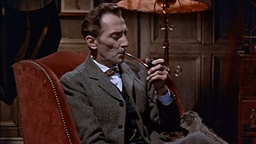 Either man could have played the lead, but it would be Peter Cushing who starred as Holmes in the lavish production. He had the sharp, lean features that are the stock and trade of a successful screen Holmes. Just as importantly, he was an excellent actor. There are quite a few Sherlockians out there who consider him the finest Holmes.
Either man could have played the lead, but it would be Peter Cushing who starred as Holmes in the lavish production. He had the sharp, lean features that are the stock and trade of a successful screen Holmes. Just as importantly, he was an excellent actor. There are quite a few Sherlockians out there who consider him the finest Holmes.
A close study of Cushing’s performance leaves one with the distinct impression that Jeremy Brett was quite influenced by his mannerisms. The explosive movements, the use of his hands, the theatrical flair in delivering lines: I find more of Cushing in Brett than from any other Holmes.
He brought a sense of gravity to the role, which was fitting for Hammer’s gothic atmosphere. Lee would give a solid performance as Sir Henry Baskerville. And his look of terror as a non-Canonical tarantula crawled on his shoulder was authentic: he was dreadfully afraid of spiders!
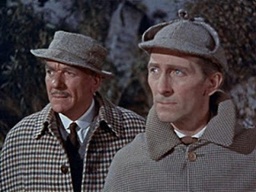
Deserving of special mention is Andre Morell as Watson. He took the prevailing image of the good doctor as a doofus (thank you, Nigel Bruce) and turned it completely on its head. I believe there have since been better performances, but none more important. Morell showed that the character could be translated to the screen as Doyle wrote it. Holmes’s assistant could be more than comic relief.
The viewer can understand why Holmes kept Watson around; something that made no sense with Nigel Bruce’s character.
I was amused that Frankland is converted into a bishop (and he’s the etymologist, not Stapleton) and actually plays the role in the Bruce style.
Francis De Wolff is so unpleasant as Dr. Mortimer that I hoped he was going to be the killer. The man clearly has some anger issues.
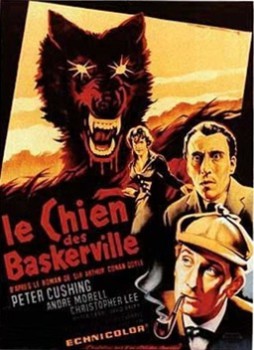
This was intended to be the first of a series. However, it did not fare well critically and wasn’t a smash at the box office, so the idea was dropped. It has been reported that the Doyle Estate wanted too much for rights to another film. Hammer would have made quite a “Creeping Man”!
I always think of the word “garish” when this movie comes to mind. But it remains one of the better attempts and is certainly worthy of multiple viewings.
Peter Cushing would don the deerstalker again (succeeding Douglas Wilmer) in a sixteen episode British television series in 1968. Cushing landed the part after Robert Stephens and Eric Porter were unsuccessfully pursued. He then made one more Holmes film in 1984: The Masks of Death. That was intended to be the first of multiple Holmes films for Cushing, but his health was failing and it wasn’t possible to shoot even one sequel.
Though he was not called upon to play the great detective, Lee would begin a long association with Sherlock Holmes. He would play Sir Henry Baskerville in this Hound; Sherlock Holmes just three years later in the German film, Sherlock Holmes and the Necklace of Death, and Mycroft Holmes in 1970’s The Private Life of Sherlock Holmes.
He would return as the great detective in two made-for-television movies in the early nineties. The plots are plodding, but Lee plays a solid Holmes. You, dear reader, of course, already read my column on Lee’s turns as Holmes, right?
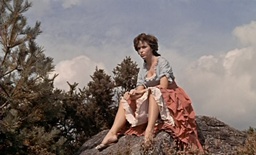
Hammer’s Hound had significant story changes, from the Hugo legend to the final showdown, with notable differences in between. For example, Stapleton’s conscience-stricken sister becomes a hot-blooded daughter. However, it is still clearly recognizable as The Hound of the Baskervilles and it makes a refreshing change from the same story that is portrayed in film after film. Not every movie could pull this off. Cushing’s version does so.
The Hound has not been tackled on the big screen since Cushing’s version. Along with Rathbone’s production, it remains the standard others are measured against. Cushing would revisit The Hound himself in a two-parter for his 1968 BBC television series, Sherlock Holmes. It clearly reflects a non-film budget, but is certainly a solid, if unspectacular, production.
Peter Cushing appears on just about every “Best Holmes” list and this Hound is the most commonly known version of his work as the great detective. You can argue which is better: Cushing’s Hound or Rathbone’s (Ian Richardson’s version might be number three, but I prefer his Sign of the Four). It may simply come down to a preference of color or black and white. They’re both that good.
Bob Byrne founded www.SolarPons.com, the only website dedicated to the ‘Sherlock Holmes of Praed Street’ and blogs about Holmes and other mystery matters at Almost Holmes.
For over a decade, he ran HolmesOnScreen.com, the Net’s leading resource for Holmes in film and on television.
I’m definitely adding this one to my Netflix queue (if Netflix has it)! I imagine Cushing could do an excellent Holmes, so I’m glad to know that if I like him in this film, there is the BBC TV series to follow it up with.
[…] (May 26) was the late Peter Cushing’s birthday. So, The Public Life of Sherlock Holmes looked at his 1959, gloriously colorful version of The Hound of the Baskervilles. It has stood through the years as a favorite for most […]
I have the surviving BBC tv episodes with Cushing. “Surviving you say? Do tell, Bob.”
Sadly, the BBC routinely wiped and reused master tapes into the seventies. So several episodes of Cushing’s tv show are lost.
Watching this series is kind of like watching an old soap opera for sets, camera angles, etc. But it’s still a nice Holmes show.
Cushing’s Holmes wasn’t as arrogant as Douglas Wilmer’s (Wilmer did not enjoy the experience, quit after one season and Cushing replaced him). I like him.
The Masks of Death is tough to watch: Cushing is painfully thin and is clearly nearing the end of his life. It might be on youtube but hasn’t been released on DVD. I have an old VHS version.
This was intended to be the first of a series.
========================================
Nor did A Study in Terror, Young Sherlock Holmes The Great Mouse Detective, other Sherlock Holmes-based or inspired films made from 1959 to 1988 which either stood as attempts at franchises or hinted at sequels but did not produce any. No Sherlock Holmes film reached U.S. theaters from 1989 to most of 2009.
http://monsterkidclassichorrorforum.yuku.com/topic/43299/Sherlock-Holmes-Films–Reachd–Theaters–1959–1988#.U4Zp2jgU9jo
I mentioned in a prior post that the intent was to have Christopher Lee’s Holmes meet Jack the Ripper after his “SH & The Deadly Necklace.” But that was such a muddled mess (and Adrian Conan Doyle was his usual greedy self) that it died as a solo effort. What would have been the sequel was authorized by Doyle and became “A Study in Terror.” Which I think is a good Holmes film.
The two Holmes vs. the Ripper movies will be explored in a future column.
Back in 199, Sherlock Holmes and the Vengeance of Dracula (SHATVOD) was one of the hottest properties in Hollywood. Christopher Columbus (a big name at the time) was ready to direct.
But it fizzled out and, prior to Downey Jr.,s movie, was the last big attempt at a big screen Holmes film.
Here’s a review of the script:
http://scriptshadow.blogspot.com/2010/02/sherlock-holmes-and-vengeance-of.html
[…] Cushing (whom you read about here, of course!) starred in a BBC tv adaptation of Caves in 1964. Unfortunately, only clips have […]
[…] Here’s a link to an essay I wrote last year on his Hammer Hound. […]